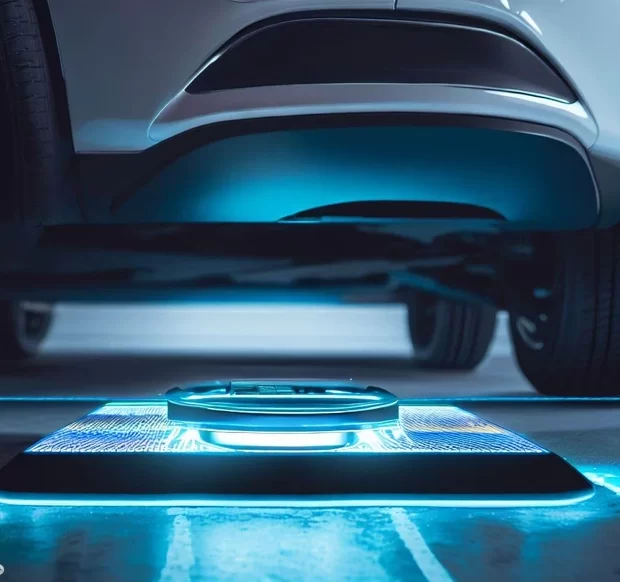Wireless charging technology is transforming the electric vehicle (EV) industry by eliminating the need for plug-in charging stations and providing EV owners with unprecedented convenience. Several major automakers, like BMW, already offer pads that allow vehicles to charge wirelessly. Also, Australian automotive engineering startup “Lumen Freedom” has rolled out wireless electric taxi charging in the UK in October 2022. There have been experimenting with wireless charging technology in recent years to make it an integral part of their EV offerings. In this blog, we will look at the impact of wireless charging on the EV industry and how it has the potential to change the way we charge our cars.
Jump Ahead
- ➤ How does Wireless EV Charging work?
- ➤ Benefits of Wireless Charging Technology.
- ➤ The Impact on EV Industry.
- ➤ Companies investing in wireless EV Charging Technologies.
- ➤ Challenges involved in adoption.
How does Wireless EV Charging work?
Wireless charging technology transfers energy via an electromagnetic field between a charging pad on the ground and a receiver coil installed on the bottom of the EV. The procedure is similar to how wireless charging for smartphones works, and it can be performed while the vehicle is parked or even in motion. The technology can reduce the need for plug-in charging stations and make electric vehicle charging more convenient for drivers.
Benefits of Wireless Charging Technology.
One of the primary benefits of wireless charging is that it does not require a physical connection between the charging station and the EV. This eliminates the need for EV owners to spend time looking for a charging station, manoeuvring their vehicle into position, and plugging it in. Instead, they can park their vehicle over a charging pad and wait for the charging process to begin. This is especially useful for drivers who struggle to manoeuvre their vehicles in tight spaces or want a more convenient way to charge their EVs.
Another benefit of wireless charging is that it can be done while the vehicle is moving, a process known as dynamic wireless charging. This technology entails installing wireless charging pads along roadways or highways, which can charge electric vehicles as they drive over them. This has the potential to greatly increase the range of EVs by eliminating the need for drivers to stop and recharge their vehicles at charging stations. Furthermore, dynamic wireless charging may enable EVs for long-distance travel, which is currently a significant barrier to EV adoption.
The Impact on EV Industry.
The impact of wireless charging on the EV industry goes beyond mere convenience. It may also help to lower the cost of EV ownership. Traditional plug-in charging stations necessitate a substantial amount of infrastructure, such as wiring, cables, and equipment. On the other hand, wireless charging pads are relatively simple and inexpensive because they only require a charging pad and a receiver coil on the vehicle. Wireless charging may thus be more cost-effective for EV owners and station operators.
Wireless EV charging technology has the potential to increase consumer adoption of EVs. Many people hesitate to switch to EVs due to range anxiety and difficulty finding charging stations. Wireless EV charging can alleviate these concerns by making EV charging more convenient and increasing EV range. Furthermore, wireless charging may make electric vehicle ownership more accessible to people who live in apartments or do not have access to a personal charging station.
Companies Investing in Wireless EV Charging Technologies
Several companies are developing wireless charging technology for electric cars, with many trial applications already taking place. Here’s a look at some of the companies leading the way:
- BMW: The German automaker has already introduced a wireless charging system for its 530e plug-in hybrid sedan in some markets, with an inductive charging station and a secondary component fixed to the car.
- Lumen Freedom: This Australian company has created a static and dynamic Wireless Electric Vehicle Charging (WEVC) system, already certified and used by McLaren on its Speed Tail Hyper-GT.
- WiTricity: A spinoff from the Massachusetts Institute of Technology, WiTricity is a leading developer of wireless charging technology for automotive applications. Its “high-efficiency 3.6-11 kW electric-car charging development system” has been licensed by Toyota and other manufacturers.
- Qualcomm: The US-based company developed the ‘Halo’ wireless charging solution used by the BMW i8 safety car in the Formula E racing championship.
- SAE: In October 2020, the Society of Automotive Engineers (SAE) announced a common standard for wireless charging systems running at speeds of up to 11kW, which should help speed up development and ensure interoperability between different products.
Challenges involved in adoption
Despite the numerous advantages of wireless charging, some issues must be addressed. For example, because the technology is still in its early stages, only a few wireless charging stations are available to EV owners. Furthermore, installing wireless charging infrastructure can be prohibitively expensive, potentially impeding widespread adoption. There are also concerns about wireless charging’s efficiency, as some studies have shown that it can be less efficient than plug-in charging.
Bottom Line
Finally, wireless charging technology has the potential to transform the electric vehicle industry by making charging more convenient, affordable, and accessible. While there are still some issues to work out, the benefits of wireless charging are undeniable. As more automakers and charging station operators invest in this technology, we can expect an increase in EV adoption and a reduction in transportation-related carbon emissions.

